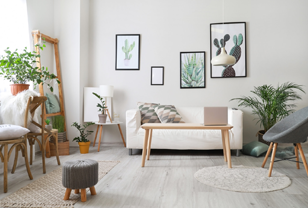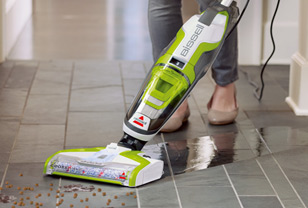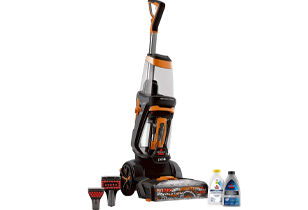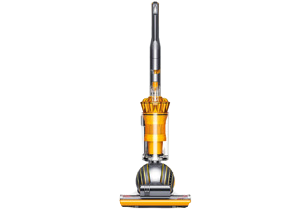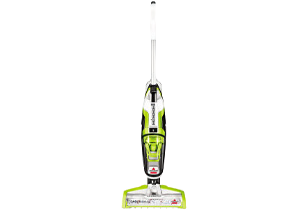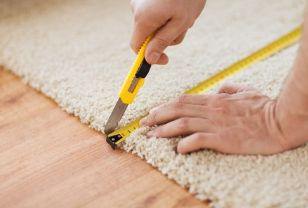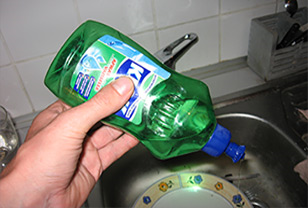How to Clean Laminate Wood Floors Without Streaking: Step-by-Step Tutorial (2024)
So, naturally, you might be wondering how to clean laminate wood floors without streaking.
The answer is a lot simpler than you’d think! In this detailed guide, we will tell you all you need to know about how to clean laminate wood floors without streaking.
What Are Streaks?
Laminated floors are a cheap alternative to hardwood floors. It gives you virtually the same properties as hardwood for a fraction of the price. These synthetic floorboards are stable, durable, and on top of all, they are beautiful.
But one problem with them is that they are very prone to streaking (smearing). Streaks are unsightly and can ruin the look of your floors. Without the proper technique, every time you pick up a mop to try and clean it, the mop would just leave them everywhere.
It’s not uncommon for people to just get so fed up, they just ignore it altogether and just let the streaks build.
Obviously, it’s not a good thing. Streaks — other than looking ugly — decrease the longevity of your floor. Streaks are a combination of water, dirt, and chemical residues from cleaners and soaps. Letting them soak into your floor is a terrible idea.
Why Do Streaks Appear on Laminated Floors?
Laminated floors are especially susceptible to streaks because of the tiny grooves on their surface. These grooves are very porous. As a result, they can retain moisture, soap residues, and dirt very well. It’s often made worse by your mop dragging them across the floor, leaving streaks and smudges everywhere.
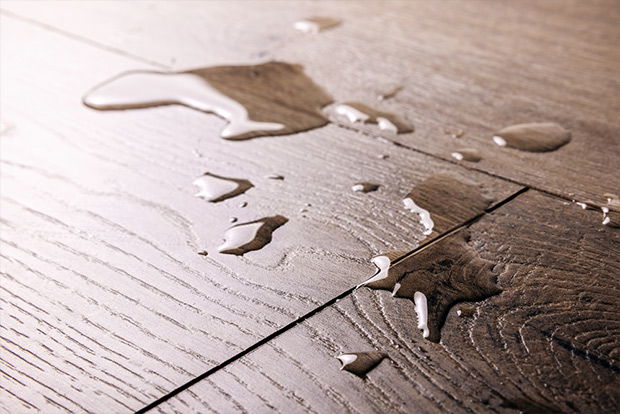
What Kind of Cleaner to Use for Laminate Floors?
Picking the correct type of cleaner is a very important step in this how to clean laminate wood floors without streaking guide. Using the wrong kind of cleaner could create streaks, dull the color of your floor or worse, damage your floor.
Natural vs. Commercial Cleaner
The first step is to select the right cleaning agent. Since chemicals tend to make a very bad pair with laminated floors, we recommend using natural cleaners. Natural cleaners tend to be more effective than commercial cleaners since they don’t contain a lot of chemicals. This means they would leave less streaks in their wakes.
Another benefit of using natural cleaners is that they are very cheap and accessible. As a matter of fact, you can mix them at home!
But this doesn’t mean that commercial cleaners are bad. For cases of heavy stains that natural cleaners aren’t capable of dealing with, you may have to resort to commercial cleaners.
Despite being filled with chemicals, they are highly effective. A spritz of the stuff on a stained laminate floor and you’ll have yourself a clean floor in no time. However, like we said earlier, they are more likely to cause streaks on your floor.
Fortunately, there have been many commercial cleaners that are advertised to be “streak-free”. Mileage may vary, but if you choose to use commercial cleaners, pick only these types.
How to Make DIY Laminate Floor Cleaner at Home
Remember how we said you can mix natural homemade laminate floor cleaner? This short section can show you how!
All in all, we have here four different recipes that you can test out depending on what you have available to you.
Important note: you should only use distilled water to mix these cleaners.
Tap water is more convenient, but it may contain dissolved minerals inside that will cause streaks to form. Distilled water has been filtered from these minerals and so will be more effective at cleaning your floor without residue.
White Vinegar
In a spray bottle, mix equal parts white vinegar and distilled warm water together. So, one cup of white vinegar for every gallon of warm water.
Shake the bottle to let the two ingredients commingled. And that’s it! You have a decent no streak laminate floor cleaner in hand.
One thing about this mixture: it could be a bit smelly if you don’t like the smell of white vinegar. If it turns you off, you can add a few droplets of essential oil to the mixture to make it smell better. Something pleasant like lemon will do a good job at masking the smell.

White vinegar cleaner can be kept for a pretty long time. You can put it away for a month and it will still retain its cleaning effect.
Baking Soda
Baking soda can be found in virtually every supermarket and all baking supply stores. This white, powdery substance can become a powerful cleaner when it is properly mixed. However, unlike white vinegar, you will need to use several different ingredients.
Here is a list of everything that you will need:
- Baking soda
- Dishwashing powder
- White vinegar
- Warm water
In a spray bottle, combine ⅔ cups of baking soda, ½ cups of dishwashing powder, and two tablespoons of white vinegar. After that, pour a gallon of warm water on top. Shake the bottle to mix them all together.
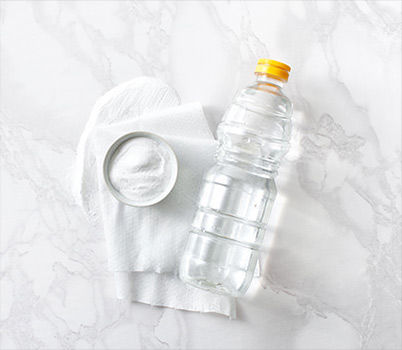
The combined cleansing effects of the dishwashing powder, vinegar, and baking soda will wipe out even the strongest stains.
➜ RELATED: How To Clean Tile Floors With Vinegar, Baking Soda, And Lemon?
Tea
It may be surprising to learn that the flavorful black tea you drink every day can also be used as a house cleaner. The astringency of the drink can cleave through dirt and stains like butter. Additionally, tea also has a polishing effect on laminated floors. But nevertheless, since tea is quite expensive compared to other ingredients in this list, you should only use this method in emergencies.
Buy the cheapest kind of black tea you can find on the shelf for this purpose. There’s no need to waste that expensive Earl Grey.
Go through the brewing motion as you normally do. Put the teabag in the cup and pour hot water on top. Steep the tea for around 3 or 4 minutes. You will want every molecule of tea essence to be sucked out of the dried leaves. Throw the tea bag away after the steeping time has elapsed.
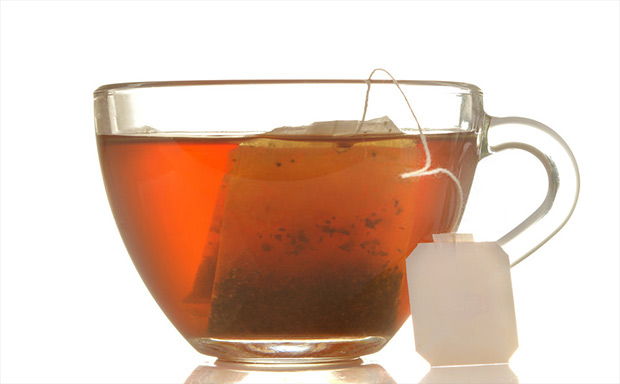
Allow the tea to cool.
Once it does, pour it into a spray bottle. Top the bottle with warm water. You can now use it as a cleaner!
Baby Shampoo
Baby shampoo was formulated to be as gentle as possible. As a result, it is often used for cleaning sensitive floor types, including laminate flooring.
Pour around a gallon of warm water into your spray bottle. Then, scoop up a tablespoon-full of baby shampoo powder and add it into the bottle. Shake the bottle to let it mix. You will know the moment it has mixed when the liquid inside begins to bubble.
How to Clean Laminate Floors Without Streaks
For general cleaning, this is the best way to clean laminate floors without streaking. Perform this cleaning procedure once every two weeks.
Step 1: Check the Effectiveness of Your Cleaner
After you have purchased or mixed your bottle of laminate floor cleaner, you should test it to see how effective it is, first. You don’t want to slather all of them onto your floor and find out later that they don’t work or, worse, they negatively affect your floor.
One trick you can use is to find an out-of-the-way spot on the floor. For example, at the corner of the room or behind the couch. Spritz a little bit of your cleaner there and wipe.
Leave it there for a few minutes, then check back. If the spot is cleaned, then proceed. However, if the floor looks dull, streaky, or otherwise damaged by the cleaner, find or mix a different cleaner type.
If nothing works, you may need to consult a floor cleaning professional.
Step 2: Vacuum the Floor
One of the causes for streaking is excessive dirt and dust. So, before you take out a mop, use your vacuum to clean up the surface.
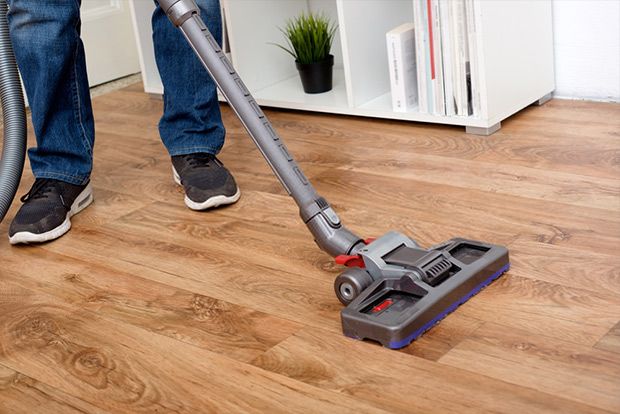
Despite the lamination layer being hardened to protect the floorboards from being scratched, it is still very sensitive. Don’t take any chance. Most vacuum cleaners will come with an option to disable the motorized brush roll. Do so before you vacuum.
Haven’t had a good vacuum cleaner yet? We have several reviews for the best vacuum cleaners out there, some of which are great for laminate floors. Check out our Dyson V7 for more detail.
Anyhow, we digressed. Track your vacuum cleaner across the floor while following the wood grain. This will maximize the amount of dirt being picked up.
Other than the floor itself, pay attention to the corners and crevices. Dirt and debris could build heavily there since they are the areas that are often neglected.
Step 3: Use the Cleaner
Once everything has been nicely vacuumed up, it’s time to bust out your cleaner.
Pick one wall and stand in front of it with your back to the rest of the room. This will allow you to apply the cleaner without stepping onto the freshly-applied cleaner as you move backward.
Spray the cleaner onto the floor so that it leaves a faint mist on the surface. Do not apply too much so that the floor becomes soaking wet. Too much cleaner is harmful and can cause the floor to be damaged or become streaky.
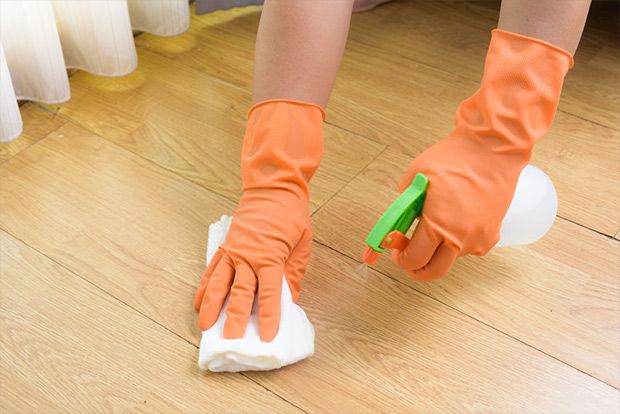
Step 4: Mop the Floor
Once you have applied the cleaner, it’s time to mop. Use straight, even movements. Keep the pressure gentle and don’t press down too much on the mop.
Give every area of the floor equal treatment. Streaks would form if you focus on scrubbing an area too much and neglect others.
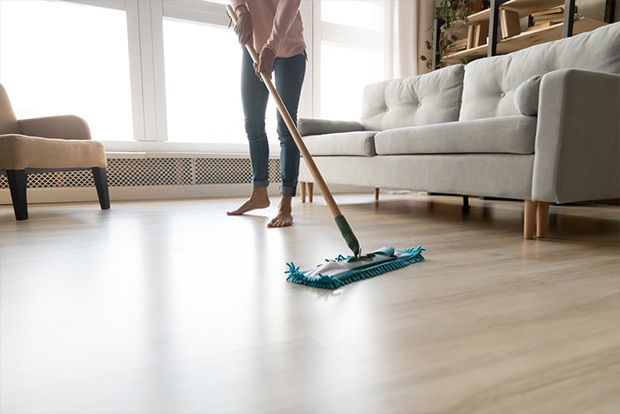
Step 5: Dry Immediately
Arguably, this is the most important step in this how to clean laminate wood floors without streaking guide.
Once you have mopped the entire floor, take out a dry microfiber mop pad and dry everything immediately. Do not wait. If you do, the cleaner will have the time to soak into the floorboards and cause streaking.
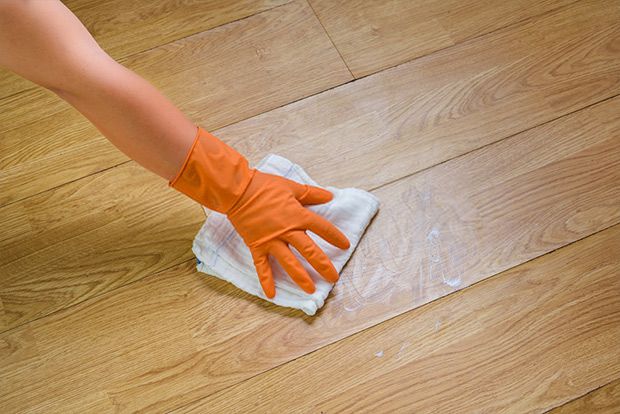
Go through the whole floor and ensure that by the time you’re finished, there’s no wet spot on the floor. Buff the floor while you’re at it, too, to give the surface a nice shine.
And that’s how to mop laminate floors without streaks during day-to-day cleaning! In hindsight, it’s pretty simple. All you need to do is to choose the right cleaner, be careful, and everything will fall into place.
This cleaning routine can be applied to virtually any kind of laminate floor (this is also how to clean PERGO floors without streaks, if you’re looking for info on this particular type.)
How to Spot Clean Laminate Floor
Another thing that we’re often asked about cleaning laminate floors without streaking is how to deal with localized stains and spots. Normally, you can treat it using the exact cleaning method above: spritz a bit of cleaner, mop, then dry.
However, it may not work for tough stains. In that case, you will have to use rubbing alcohol.
Rubbing alcohol is a powerful cleaner that will wash away any stain in only a minute or two when it’s used correctly. But you have to be very careful with it. If it's used in too high concentration or left for too long on the floor, the alcohol can strip away the protective top coating of the laminated floors.
So, the way to do it is this.
First, take a cotton ball and apply a few drops of alcohol onto it. Then, rub the alcohol-laden cotton ball against the spot until it clears. Once it does, immediately dry up the spot from alcohol residue with a dry mopping pad.
How to Remove Stubborn Stains on Laminate Floors
Things like wine stain, crayon traces, and heel marks are very difficult to deal with on laminate floors. Depending on the type, you need to use the right kind of chemical or tool in order to deal with them effectively and streak free.
Beverage and Alcohol Stains
These are the simplest to deal with. If the drink has just recently been spilled and hasn’t had the time to soak into the floorboards, use a dampened microfiber pad to wipe across the wet spot. It should come off without any fuss. Remember to dry thoroughly afterward.
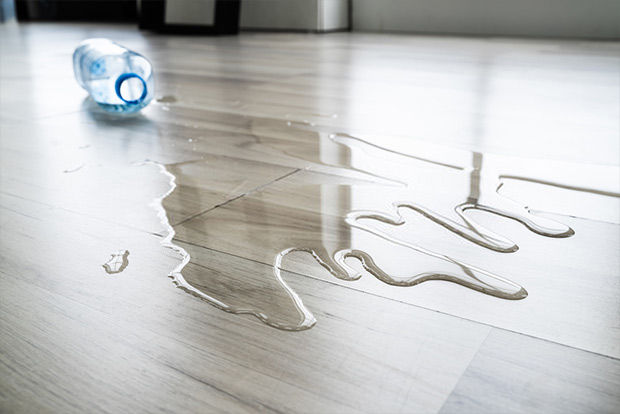
On the other hand, if it has developed into a dried, persistent stain, you can use the rubbing alcohol trick above to deal with it.
Stuck-on Chewing Gum
If a chewing gum is stuck tight to the laminate floorboard, use a plastic knife or scraper to dislodge it. Don’t use anything metal to avoid scratching the delicate surface.
Once the chewing gum has been lifted, clean up any residue with a dampened microfiber mop. If the chewing gum residue doesn’t come off, add a bit of mineral spirits to the mop.
Dry the spot carefully so that there’s no moisture left on the surface.
Crayon or Ink Marks
If you have children in the house, this small tip will probably be the most useful one in this how to clean laminate wood floors without streaking guide.
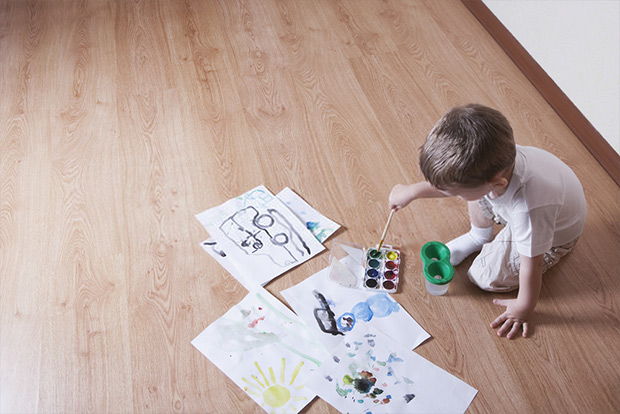
For crayons, add a bit of mineral spirits to a microfiber mop pad. Scrub the crayon marks and it should come out easily.
As for ink, it is a little bit more complicated. If you have mixed a natural cleaner solution like we instructed earlier, spritz it on top of the ink marks. Scrub carefully with a mopping pad, then dry.
An alternative is to use specialized commercial ink remover solutions. Make sure that the brand you choose is compatible with laminated floors. Read the instruction on the bottle and apply it to the ink.
As always, dry carefully after you’re done.
Nail/Shoe Polish
Nail or shoe polish stains on laminate floors can be removed using acetone.
Acetone is very similar to rubbing alcohol. While its cleaning power is great, you have to be careful while you’re using it lest you damage the top lamination layer.
Add a few droplets of acetone nail polish remover to a microfiber mopping pad. Mop up the stain until it comes out. Immediately mop up the acetone residue with another damp mopping pad.
Dry thoroughly the spot to take care of extra moisture.
Heel Marks
Dark heel marks can be cleaned with a standard eraser. Scrub on the mark gently with the eraser until the mark is lifted.
Although the lamination could handle the scrubbing action, it’s still best that you be gentle.
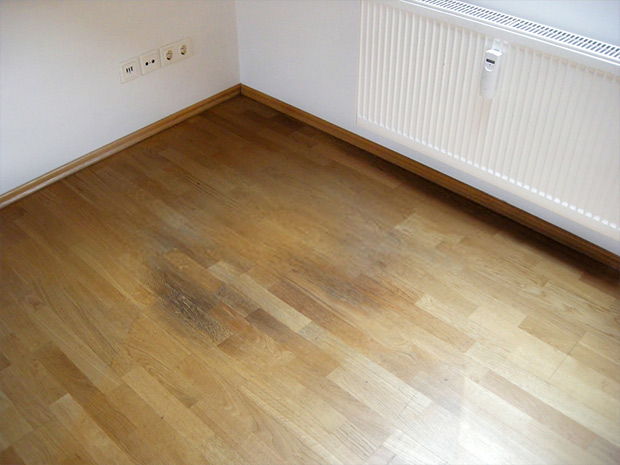
Grease Stains
The way to remove grease stains is a little bit more unconventional. It is very difficult to lift grease from the surface of laminate floors even with the aid of strong cleaning chemicals. One thing you can do is to freeze it. Once the grease has been frozen, you can scrape it off the floor like you do with a piece of chewing gum.
Fill a plastic bag with ice and leave it right on top of the grease stain for a few hours until it solidifies. After that, just scrape it off with a plastic knife. Do not use metal utensils. They will damage the floor.
There will still be some leftover residues. To deal with them, spritz some window cleaner onto a microfiber mopping pad and scrub them off. Wipe for a second time with a dry mop to clear up any excess moisture.
How to Shine Laminate Floors
Laminate floors do not need to be polished or waxed. If you apply polish or wax to laminate floors, streaks and ugly hazes can form. They will make the floor look dull and lifeless.
Instead, just clean and mop the floor regularly (and more importantly, properly). The lamination layer on top — if it’s well-maintained — is more than capable of protecting the wood fiber underneath and keeping the floor shiny.
How to Maintain a Laminate Floor?
The better you maintain your floor, the less you have to work to clean it. Your floor will also benefit from good maintenance, too. It will look better and will be more durable over time.
Combine this with your new knowledge on how to clean laminate wood floors without streaking and your floor will remain beautiful for a very long time!
Take Care of Any Spill Quickly
When you spill something on your laminate floors, clean up the spill immediately. If it sits for long enough on the floor, a stain will develop that is going to be really difficult to get rid of.
To do this, dampen a cloth and place it right on top of the spill to soak up the liquid. Rinse and repeat until the area is fully cleaned out. Mop up the area thoroughly afterward until there’s no trace of moisture left.
Enforce a “No Shoe” Policy
Dirty shoes will bring dirt into the house and leave them all across the floor. As a result, if you care about the state of your floor, enforce a “No Shoe” policy.
Tell anyone coming inside to leave their shoes at the door. Place a doormat there, too, so that people can clean their shoes and feet before coming inside.
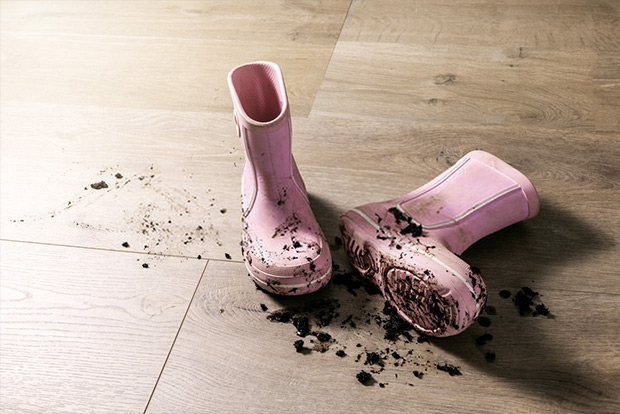
Avoid Direct Exposure to Sunlight
This news may come as a shock, but too much sunlight is harmful for your laminate floors. Prolonged exposure can make the affected floorboards become sun-bleached. Its color will fade and look very dull after a few months.
That’s why, if you wish to protect your floor, it’s best that you set up curtains for your windows. Close them in the middle of the day or early afternoon. The sun is usually the harshest during these times.
Are Laminate Floor Cleaner Machines Worth It?
The job of cleaning laminate floors is difficult enough that people have come up with specialized machines for the job.
But are they worth it?
The short answer is: yes, definitely. The best laminate floor cleaner machines will make day-to-day cleaning a whole lot easier. However, it is important to pick the correct kind of cleaning machine. There are so many types out there.
Some models will automatically apply detergent as you sweep the floor. A few have steam cleaning modes that can help you deal with stubborn stains.
For sensitive, unsealed laminate floors, there are some models specially designed to be as gentle as possible to minimize damage.
All in all, look through the product description of each cleaner model before you make your purchase to make sure that it works with your floor. Choosing the wrong one could spell disaster. For example, if you were to steam clean an unsealed laminate floor, the board could warp from the heat.
Conclusion
Hope this guide on how to clean laminate wood floors without streaking has been helpful for you! Taking care of laminate floors is difficult, but ultimately worth it with its natural beauty and cheap installation cost.
Plus, as you can see, it is not as complicated as most people think it is. You really only need to be careful and have proper knowledge to keep it shiny (which you now have!)




